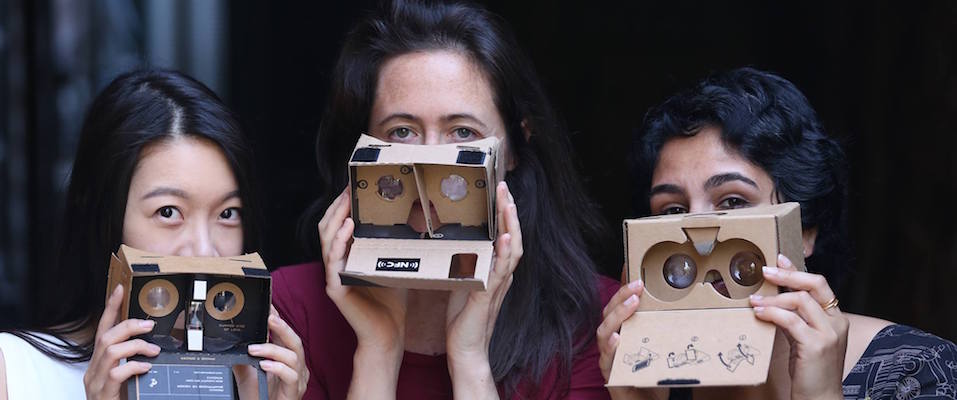About 22 seconds into the video, Mohammed, a Syrian refugee in Berlin, says, “You can’t imagine what’s the meaning of, ‘Wait. Just wait.’ And for what?”
But you are already starting to imagine it. The camera has recorded Mohammed’s surroundings in 360 degrees.
Dragging your cursor along the screen from left to right, you see the grey Berlin street, the trees above free of leaves, the unknown people in coats and backpacks passing, and the long lines at the Office for Health and Social Affairs in the background. It’s as if you’re submerged in the anonymous tedium of entering a foreign country, waiting with no seeming end on a bureaucratic process that may change your life.
The video is one of nine profiles produced by Lakshmi Sarah and Melissa Bosworth. The profiles were grouped together earlier this year in a project called, fittingly, “The Wait: Inside the Lives of Asylum-seekers in Germany.”
The intention in filming these nine refugees in 360 degrees is “so that a person can actually feel like they’re standing there,” says Bosworth. And if you happen to own a Google Cardboard or other virtual reality (VR) viewer, you can add three dimensions to the experience.
Sarah and Bosworth graduated in May 2016 from the New Media program at UC Berkeley’s Graduate School of Journalism. Their project, and subsequent work, is adding to the fast-growing conversation around using the technologies of 360-degree video and VR for journalism.
A month after graduating, the two launched a company called Tiny World Productions. They recently produced another 360-degree video profiling three homeless people living on the streets of San Francisco for KQED, an NPR affiliate. And Sarah spoke in June on a panel about VR at the annual conference of Investigative Reporters and Editors (IRE), a national organization.
It won’t be the only journalism conference this year to treat the subject. “You look at conferences, and it’s all this,” said Richard Koci Hernandez, a new media professor at the Graduate School of Journalism who worked with Sarah and Bosworth. He pointed to an upcoming Online News Association conference in Denver, which features five panels and workshops in three days on 360-degree video and VR.
Despite the increasing next-best-thing glare surrounding the twin technologies, Sarah and Bosworth were “starting from zero” in filming and editing their project on refugees, Hernandez said. “Normally in an educational environment there’s someone who knows,” he said. “But not this time.”
After releasing “The Wait,” the pair posted a few how-to documents on Medium under the name of their fledgling company. “When we were figuring out how to do this, there weren’t any guidelines, so we figured we would share this,” Bosworth said. In doing so, “they created value for themselves and for us,” Hernandez said. “They left a playbook, with best practices”—from choosing software to framing scenes and stories when filming in 360 degrees.
They also left behind equipment that the department purchased for the project and that another student is now using to film nomadic people in Mongolia who are driven to migrate to cities.
Sarah said that part of the challenge in telling news stories in 360 degrees is that “people want to look around, and they may be missing what you want to show them.” For Hernandez, looking around in some of the scenes of “The Wait” is “boring,” but he chalks that up to the learning process.
At Tiny World Productions, Sarah and Bosworth are also figuring out what type of stories best lend themselves to the technology. Bosworth is interested in filming at the U.S. border with Mexico; Sarah, in environmental stories set in India.
The goal: “being able to tell stories of people, and places, you might not have access to—places you can’t go, or might not go,” Sarah said.
Bill Mitchell, a former faculty member and current contributor to Poynter Institute, a leading journalism organization and website, noted that “The Wait” shared subject matter with one of the early high-profile uses of 360-degree video and VR by a news organization—“The Displaced,” a November 2015 New York Times story on refugees. The Times sent more than 1 million Google Cardboard viewers to home subscribers so they could watch the 11-minute video about three children displaced by war, and Mitchell, who was also a pioneer in creating news websites at the San Jose Mercury in the 1990s, reviewed the experience. His verdict: The technology seems closer to the mouse we all use on our computers in staying power than the now-forgotten “cue cat,” a digital navigator that never got off the ground but also was “hot” for a time. Put another way, 360-degree videos and VR may have more usefulness than novelty, he said.
“It’s interesting that this and the New York Times foray both deal with asylum-seekers,” Mitchell said. “It’s a group where we need to be in their shoes” to understand their story.
Sarah and Bosworth hope to collaborate with established news outlets in telling future stories. The technology is where multimedia storytelling was 10 years ago in most newsrooms, said Shazna Nessa, director of journalism at the Knight Foundation—meaning there are few if any visual journalists in most newsrooms who can produce 360-degree and VR video.
“People in newsrooms paved the way with multimedia,” said Sam Gill, vice president for learning and impact at the foundation and one of three authors of a recent report, “Viewing the Future? Virtual Reality in Journalism.”
Gill noted that entry costs to producing 360-degree and VR videos are much lower than, say television—or newspapers themselves. This will make it easier for young people and start-ups to innovate.
Nessa said that media outlets will look to the technologies to “create empathy and human connections,” and suggested that they may be useful for covering natural disasters, or for explanatory journalism.
In any case, it’s still “early days” for so-called immersive storytelling in newsrooms, and likely entertainment, not journalism, will lead the way in developing the technology, Gill said.
But David Cohn, Hernandez’s colleague at the graduate journalism school and senior director at Advance Publications, said it was “important for [Sarah and Bosworth] to get in on the ground floor, and grow with the space. There’s lots of room.”
Hernandez said he learned one thing from being around Silicon Valley as a visual journalist for decades: “There’s something to being an early adopter. There’s more positives to negatives. You fall flat on your face, but at least you learn.”





















